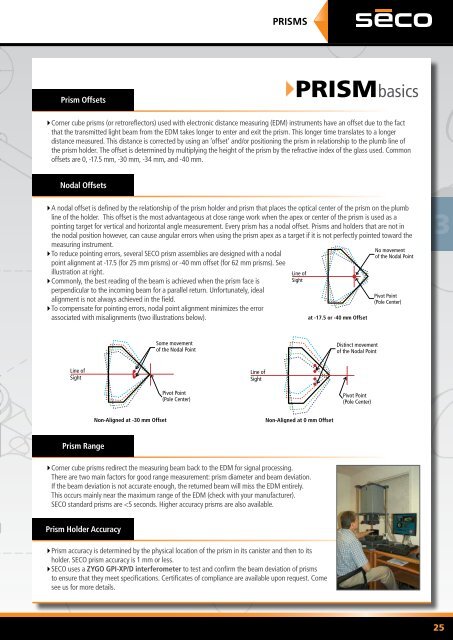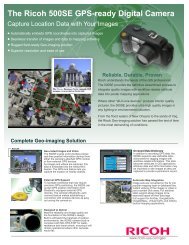2015 CATALOG
SECO Catalog - Western Data Systems
SECO Catalog - Western Data Systems
You also want an ePaper? Increase the reach of your titles
YUMPU automatically turns print PDFs into web optimized ePapers that Google loves.
PRISMS<br />
Prism Offsets<br />
PRISMbasics<br />
`Corner ` cube prisms (or retroreflectors) used with electronic distance measuring (EDM) instruments have an offset due to the fact<br />
that the transmitted light beam from the EDM takes longer to enter and exit the prism. This longer time translates to a longer<br />
distance measured. This distance is corrected by using an ‘offset’ and/or positioning the prism in relationship to the plumb line of<br />
the prism holder. The offset is determined by multiplying the height of the prism by the refractive index of the glass used. Common<br />
offsets are 0, -17.5 mm, -30 mm, -34 mm, and -40 mm.<br />
Nodal Offsets<br />
`A ` nodal offset is defined by the relationship of the prism holder and prism that places the optical center of the prism on the plumb<br />
line of the holder. This offset is the most advantageous at close range work when the apex or center of the prism is used as a<br />
pointing target for vertical and horizontal angle measurement. Every prism has a nodal offset. Prisms and holders that are not in<br />
the nodal position however, can cause angular errors when using the prism apex as a target if it is not perfectly pointed toward the<br />
measuring instrument.<br />
`To ` reduce pointing errors, several SECO prism assemblies are designed with a nodal<br />
point alignment at -17.5 (for 25 mm prisms) or -40 mm offset (for 62 mm prisms). See<br />
illustration at right.<br />
`Commonly, ` the best reading of the beam is achieved when the prism face is<br />
perpendicular to the incoming beam for a parallel return. Unfortunately, ideal<br />
alignment is not always achieved in the field.<br />
`To ` compensate for pointing errors, nodal point alignment minimizes the error<br />
associated with misalignments (two illustrations below).<br />
Line of<br />
Sight<br />
at -17.5 or -40 mm Offset<br />
No movement<br />
of the Nodal Point<br />
Pivot Point<br />
(Pole Center)<br />
3<br />
Some movement<br />
of the Nodal Point<br />
Distinct movement<br />
of the Nodal Point<br />
Line of<br />
Sight<br />
Line of<br />
Sight<br />
Pivot Point<br />
(Pole Center)<br />
Pivot Point<br />
(Pole Center)<br />
Non-Aligned at -30 mm Offset<br />
Non-Aligned at 0 mm Offset<br />
Prism Range<br />
`Corner ` cube prisms redirect the measuring beam back to the EDM for signal processing.<br />
There are two main factors for good range measurement: prism diameter and beam deviation.<br />
If the beam deviation is not accurate enough, the returned beam will miss the EDM entirely.<br />
This occurs mainly near the maximum range of the EDM (check with your manufacturer).<br />
SECO standard prisms are




